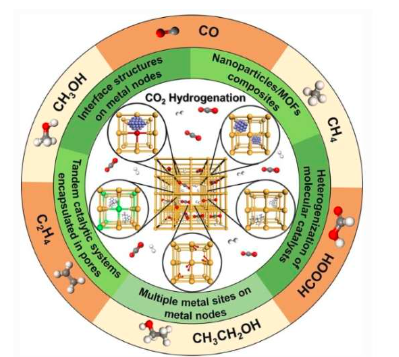Review of technologies that boost potential for carbon dioxide conversion:
Excessive emission of greenhouse gases, especially carbon dioxide, is rapidly raising the average global temperature. Capturing carbon dioxide and converting it into useful fuels and chemicals can be an ideal way to reduce carbon dioxide concentration and alleviate this serious environmental problem.
Among the technologies that show promise for the conversion of carbon dioxide is the hydrogenation of carbon dioxide. Interest is strong because hydrogen is a green and sustainable energy that can be produced continuously. Working to advance the technology, various researchers have tested a variety of catalysts for the hydrogenation of carbon dioxide, but challenges remain in applying these catalysts in industrial settings. Catalysts based on organometallic structures offer an alternative to traditional catalysts for these technologies. Therefore, the team of researchers has systematically reviewed organometallic framework-based catalysts for the selective hydrogenation of carbon dioxide with the aim of developing catalysts that have great potential in future carbon dioxide hydrogenation applications.
The team published their findings in Nano Research.
Carbon dioxide capture has become an important way to alleviate the negative impacts it has on the environment. But once the carbon dioxide is captured, researchers are challenged with what to do with the captured carbon dioxide because there have been no industrial uses for such a large volume of carbon dioxide in the past. Knowing that natural carbon hydrogenation has produced fossil energy sources, such as oil, coal, and natural gas, during photosynthesis, researchers have determined that synthetic carbon dioxide hydrogenation has great potential as a method for reusing carbon dioxide caught.
But finding the right catalyst to use for carbon dioxide hydrogenation has been a challenge because traditional catalysts require a high temperature to convert carbon dioxide. These harsh heat conditions increase carbon emissions and cause rapid sintering of the active substances. And the limited catalytic activity and selectivity for carbon dioxide hydrogenation in traditional catalysts still limit the development in the industrial environment. The researchers wanted to build new catalysts for carbon dioxide hydrogenation with higher catalytic performance under milder conditions, especially to avoid high temperatures.
The researchers focused their attention on catalysts based on organometallic structures. Organometallic frameworks, a class of crystalline materials, may provide an ideal platform to build new catalysts for the hydrogenation of carbon dioxide under mild conditions. Organometallic frameworks offer the advantage of being tunable frameworks with well-defined pores that encourage the construction of diverse catalytic sites. These catalytic structures can be used for different products, such as carbon monoxide, methane, formic acid, methanol, and C2+ products. In their research, the team carried out a detailed and systematic review of a variety of catalysts based on organometallic structures for potential use in the selective hydrogenation of carbon dioxide.
Although much progress has been made in the development of catalysts based on organometallic frameworks, the researchers note that several challenges remain. Further research is needed to address these issues. Looking ahead to future research in the area of organometallic framework-based catalysts, the researchers make four recommendations for possible future studies.
First, they suggest that more extensive design and precise synthesis are needed to build the interface structures in the metal-organic frameworks. Next, the researchers suggest that carbon dioxide conversion at low temperatures can be enhanced by introducing functional sites within the organometallic frameworks to aid in carbon dioxide activation. Their third recommendation is that deeper design of catalytic sites within organometallic frameworks is needed to reduce the dependence of target product selectivity on intrinsic properties of metals. Their final recommendation is to develop high-pressure in-situ characterization technologies, such as high-pressure in-situ X-ray absorption spectroscopy, X-ray diffraction analysis, and Raman spectroscopy, to characterize the dynamic structural change of organometallic frameworks. based on catalysts during carbon. hydrogenation of carbon dioxide at high pressure.
“We hope that our discussion on catalysts based on metal-organic structures for the selective hydrogenation of carbon dioxide can provide some ideas to develop the catalysts enabled to achieve high activity, excellent selectivity and good stability. We believe that catalysts based on in metal-organic structures have the great development prospects and application potential in carbon dioxide hydrogenation under mild conditions in the future,” said Guodong Li, a professor with the National Center for Nanoscience and Technology.
